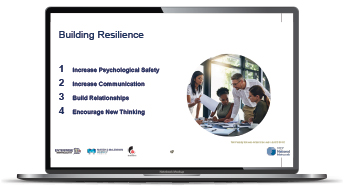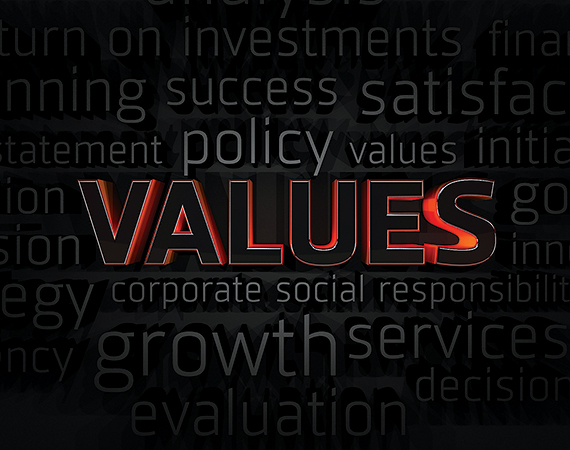The 2020 edition of Enterprise Minnesota’s State of Manufacturing® survey revealed that 92% of executives statewide said the COVID-19 economy had either a major or modest impact on our economy and business climate; 70% said it had a major or modest impact on their businesses overall.

The COVID pandemic has challenged manufacturers in many ways this year. We’ve all weathered the storm. But our ultimate goal is to get our entire team rowing together, all on the same page, moving toward that same target.
I’m a firm believer that the executives whose employees productively navigated these fraught waters did so because they were continually guided by the company’s strategic values. A recent article in Forbes magazine described a way companies can traverse that long road to recovery. Building on values, it identified four essential traits that will launch you forward in 2021 — resilience, agility, high EQ and dynamism.
Why before how
Resilience is the capacity to cope with and recover from crisis-related difficulties in ways that produce growth. But resilience connotes accomplishing more than merely bouncing back. It is the ability to gain knowledge and skills through adversity that enable you to bounce forward. I’ve worked with several companies that have reacted to changing circumstances by innovating new ways of working, producing new product offerings, and envisioning evolving roles. Maybe they’ve elevated team members or created cross-functional teams. Lori Tapani, co-president of Wyoming Machine, Inc., used iPads and tablets so employees could communicate better.
These tactics might even include helping team members develop personal plans to improve physical health, mental health or to find effective tactics to work from home productively. It’s a better approach than always being stuck in our old ways. Managers have to empower others in times of change. They have to resist the temptation to say: “It’s easier if I do it. It’ll take less time.” This reaction might be understandable, but in doing so, managers might inadvertently treat people like robots. They become taskmasters — “Do this, do this, do this, do this.”
Resilience is the capacity to cope with and recover from crisis-related difficulties in ways that produce growth.
It’s crucial to share the “why” behind our decisions. Why are we doing what we’re doing? Then we can think about the “who,” such as: Who should be involved, who should I connect with? And then it’s the “what,” specifically: What are your expectations and your tasks?
Finally, it’s the “how.” We typically jump right to the “how,” but we first need to discuss the “why,” the “who” and the “what.” Here are some quick steps we take.
- Think about the new buzz phrase called psychological safety. Create an environment in which everyone feels included. Show that we’re humans working in a safe place where employees don’t feel under attack, as if a judgmental finger is pointing right at them.
- Improve communication. During the COVID shutdowns, I’ve heard of CEOs making videos in lieu of company-wide meetings, shift meetings or daily huddles.
- Build relationships. Listen actively. Collaborate with teams in open forums, if only just to chat. It could be in a break room or on a Zoom call.
- Encourage new thinking. Learn new things. Look at personal and professional development.
Workplace Jenga
As we reflect on resilience, be mindful of agility when confronting unanticipated challenges. As Minnesotans, we all know what it’s like to get stuck on the road in a sudden snowstorm. We get through it by preparing to react to changing circumstances. That’s agility.
Ask yourself: How does your company react to changing terrain, whether they are social shifts, cultural shits or economic shifts? How did you respond to the pandemic? Or, for some of you in the Twin Cities, George Floyd’s death?

You’re probably familiar with Jenga. The object is to remove a block from the middle of a tower and place it on top without causing the structure to topple — which ends the game. Jenga gurus will describe key strategies you need to consider to pay attention to all the moves. Look at your weight distribution and placement. It’s essential to know how to shift the pieces.
Companies also need to pay attention to their different pieces, to their people. They need to identify their strengths and weaknesses and how to shift and react to their people. So, how do we create an agile workplace?
- Improve skill sets. Use a skills matrix and a training matrix to identify areas you need to develop through cross-training or team building. Yes, these can be technical, but they also might emphasize essential skills: listening, communication, self-awareness, conflict resolution and building relationships.
- Lead more, manage less. But leading is more about being proactive instead of reactive. Inspire and motivate your team; share the values and visions of your organization. Don’t prescribe behaviors. Empower your employees by positioning them to succeed.
- Provide purpose. I work with many companies that align their employees with their strategic and organizational values. Those employees tend to think, “Hey, what I do is important. My work matters.” Wouldn’t you want all your employees to feel that way?
Ensure your employees are part of your company’s mission and overall strategy, that they know what they do matters all the way up to the top. Like Jenga, we need to know how to shift them into positions of strength so they can succeed and the tower continues to stand.
27 emotions
We’ve all heard of IQ, or intelligence quotient. It’s how smart you are. EQ — emotional quotient — refers to emotional intelligence. This concept dates back to 1991, when psychologists John D. Mayer and Peter Salovey defined EQ as having the ability to recognize and understand emotions in ourselves and others.
Psychology Today calls emotional intelligence “the ability to identify and manage one’s own emotions, as well as the emotions of others.” Sounds simple enough, right? Well, no, not exactly. If it were so easy, everyone would already be doing it, and no one manufacturer would have this particular competitive advantage over another.
Achieving emotional intelligence in the manufacturing world just requires a concerted effort on the part of executives and managers, and eventually, the rest of the company’s employees. It can mean a significant boost in your company’s bottom line — almost 35%.
Your company will experience more success when you develop high-EQ leaders. High EQ improves decision-making, problem-solving and communication. One study surveyed manufacturing supervisors who had attended EQ training. They reported that:
- Their companies reduced lost time due to accidents by 50%
- Formal grievances decreased by 20%
- Plant productivity surpassed its goal by $250,000
- Profits at plants with high-EQ managers increased by 34%
Here are the components of EQ:
- Self-awareness. Can I name my emotion and recognize it? It’s more than, “I’m fine.” It is, “I’m angry. I’m frustrated. I’m fearful. I’m excited.” Does my face turn red? Do I get a lump in my throat, a pit in my stomach or a tightness in my chest? When you’re self-aware, you recognize your own emotions and how they affect your thoughts and behavior.
- Self-regulation, sometimes referred to as self-management. Do I think clearly? Do I make good decisions? Do I need to step away and pause for a minute? Am I open to new thinking? Do I compromise outcomes and results because I’m too quick to respond?
- Social awareness. You have empathy. You can understand the emotions, needs and concerns of other people. You might be quick to pick up on emotional cues, feel comfortable socially, or recognize the power dynamics in a group or organization.
- Relationship management. Am I versatile? Do I know how to modify my behavior? Do I use humor as a stress reliever if needed? Do I see conflict as an opportunity to grow? Do I ask for feedback?
Achieving emotional intelligence in the manufacturing world just requires a concerted effort on the part of executives and managers, and eventually, the rest of the company’s employees.
This, in a way, brings us back to two key factors of resilience — increasing communication and building relationships. For both, you need to ask questions and — trickier — you need to really listen to the answers. We need to use our ears two times as much as our mouths.
The dazzling outcome
Combining resilience, agility and high EQ leads to being dynamic. Being dynamic in response to employees, customers and the community will prove vital in the face of any challenge.
When your team responds to change with positivity and action, they’ll deliver positively, even when they’re under pressure. It starts with creating a positive ripple. Your daily actions and decisions must have a positive impact on your team. Think about what might happen after the implementation of something new. You need to be strategic in your decision-making as it will affect culture.
Also consider that your organization is experiencing effects from previous decisions, including maybe a few mistakes. Think about a recent action or decision that you’ve made. Perhaps it’s hiring new employees; perhaps it’s signing a new customer, modifying a continuous improvement process, or even implementing ISO standards.
Your actions will impact your company, and it could be positive or negative. Think about how a tiny drop in a pool ripples out. That same thing can happen with your decision. It ripples out and affects other teams. When it flows out and down the river, what we think is a good thing can negatively impact a department.
This phenomenon shows the importance of building relationships. I emphasized earlier that you should engage with your employees, but it bears mentioning again.
Ask yourself: How does your company react to changing terrain, whether they are social shifts, cultural shits or economic shifts? How did you respond to the pandemic? Or, for some of you in the Twin Cities, George Floyd’s death?
Do you know the names of all your employees? For those of you with large companies, you don’t have to know all 300 employees, but do you at least know your direct reports? If you can’t answer yes, I encourage you to start there.
Then there’s the next level: Do you know the names of their spouses or partners? Do you know the names of their children, the activities they’re involved in, do they have pets?
Make a point to schedule walk-throughs. Be visible. Go where your people are. Greet them while they’re eating lunch or taking breaks. If you’re working in a virtual environment, get out of your virtual office. Call them and just ask, “Hey, how’s it going?” (Remember, “fine” might not be the end-all, be-all answer.)
If you haven’t done this before, it’s not too late. Don’t be afraid to learn from past mistakes and failures. Robert F. Kennedy once said, “Only those who dare to fail greatly can ever achieve greatly.”
I encourage clients to conduct a “lessons learned” evaluation. Ask what went well, what didn’t, and what we could do differently next time. As Norman Vincent Peale said, “Shoot for the moon. And even if you miss, you’ll land among the stars.”
Realize, of course, that getting to the moon doesn’t have to happen in one shot. Focus on making incremental improvements every day. One of my colleagues likes to say, “One little step every day will help you get to your goal.” Get out of your office and onto the production floor. Your employees will see you. They’ll work toward contributing to the daily process of improvement. Recognize this progress. Commend them. Just an “atta boy” or “atta girl” can go a long way in an even longer process toward building a more dynamic company.
Bottom line
In the end, think about how you can create those positive ripples throughout the organization. I could want nothing more than to have all of my clients vying for the “Best Place to Work” award. So start with your team. Get them on board with the concepts in this article. Be intentional about building relationships and learning from failure. Analyze what you get from your employees. Do they have the skills, abilities and knowledge needed to help you become more profitable in 2021?
And analyze yourself! Are you ready to implement these changes? You are the coxswain of your crew. You are steering the boat. Are you motivating your crew and communicating with them every day? If you are, you can count on that crew to adapt and bounce forward with resiliency, agility and increased emotional intelligence. And most importantly, when we put it all together — when we’re rowing at the same speed, with the same strength and moving in the direction of our goals and targets — we are dynamic.
…
Featured story in the Summer 2021 issue of Enterprise Minnesota magazine.


